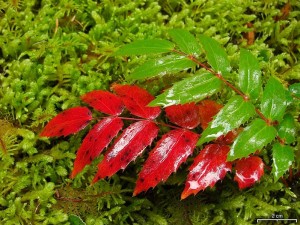 |
Previous Issues |
| Cedar Mill Community Website |
|
Search the Cedar Mill News: |
About The Cedar Mill News |
|
|||||||
| Volume 11, Issue 12 | December 2013 |
||||||
‘Tis the Season to Rethink Classic Holiday Décor
|
|||||
 |
English holly, like many other Christmas traditions, came to us with European settlers from Britain and continental Europe, where much colder winter weather and other conditions keep its growth in check. Grown commercially and by gardeners for its glossy dark green leaves and startling red berries, holly may be emblematic of the season, but it crowds out native plants in natural areas, and doesn’t provide very good food or shelter for the native wildlife that unwittingly aid its distribution.
[Ed. note: Many of the early nursery growers in Cedar Mill grew holly, and there are still acres of the trees in the area. Birds eat some of the berries, and they are distributed when the birds relieve themselves in our yards.]
Keep an eye out here for holly: A small shrub that may grow into a tall, thick trunked tree with glossy dark green leaves that have sharp spines and small white flowers that produce bright red fruits found in upland forests and the edges of wetland areas. It can be difficult for the beginner to distinguish between holly and the native Oregon Grape, so check some of the resources in this article to familiarize yourself with it.
Avoid composting the remaining leaves and berries from yard trimmings or indoor décor. Opt for tying it up in a plastic bag and sending it straight to the landfill in your weekly trash.
Removal of holly from the landscape can be tough. Try hand-pulling tender young plants (relatively easy) and digging out mature stumps (much more difficult); appropriate herbicide application may be needed. Tualatin Hills Park & Recreation and other agencies use a nifty device called a weed wrench to wrest the roots of these and other invasives from affected areas.
 |
| Oregon Grape |
For much the same look and feel as holly, consider bowers of Oregon grape.
Replicate those bright red berries and dark green leaves with a mix of bitter cherry, red elderberry, and salal branches.
To replicate the look of mistletoe, consider hanging a spring of snowberries over doorways—once people know where mistletoe gets its name (from the Anglo Saxon for ‘dung on a branch’), some of the romance of the tradition may fade anyway.
![]()
Like us on Facebook for timely updates
Published monthly by Pioneer Marketing & Design
Publisher/Editor:Virginia Bruce
info@cedarmillnews.com
PO Box 91061
Portland, Oregon 97291
© 2013